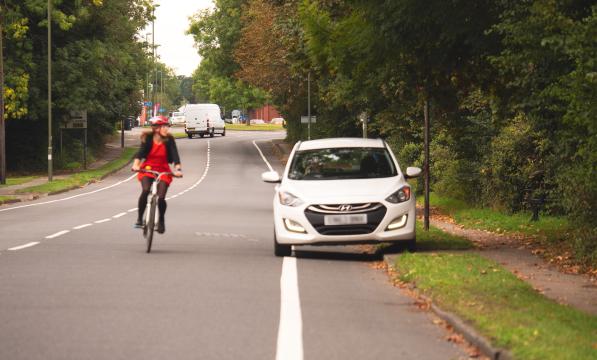Using public law in cycle campaigning: Section 39 and Judicial Review

Although section 41 of the Highways Act 1980 imposes a duty on authorities to maintain highways, the section is subject to the defence that the authority had “taken such care as in all the circumstances was reasonably required to secure that the part of the highway…was not dangerous for traffic.” (s 58(1).
Additionally, a line of well known negligence cases has established that the crossbar is set high for proving negligence against a public authority in road accident cases. See, for instance, Stovin v Wise [1996] AC 923 where it was held that whilst a highway authority had discretionary powers to require the removal of dangerous obstructions on the highway under the Highways Act 1980, it did not give rise to a duty to compensate claimants.
Although suing an authority in negligence following a road accident may produce some momentum for change, it won’t turn the clock back for the injured cyclist or grieving families. What is often needed is preventative action. Unfortunately, there are no easy answers for campaigners but, given the right circumstances; there are some useful legal tools to encourage change.
Judicial Review
One way in which to make a change to systems, policies or decisions which have a detrimental effect on cycling and to tackle them on a preventative basis is through the “public law” route of judicial review.
Judicial review is an important mechanism for holding public bodies to account – such as local councils, the highways authority, Greater London Authority (GLA) or Transport for London (TfL) – where they have made unreasonable, unfair, arbitrary, irrational or disproportionate decisions or have simply failed to act where they are required to do so.
Where a decision is made, a claimant needs to challenge the decision promptly or at least within three months (or for cases where there is a planning element, six weeks). In the first instance, the claimant has to apply for permission for judicial review and if he is successful, a timetable is set for the substantive hearing.
Many of the decisions which could be challenged fall into clearly defined actions by public authorities such as the introduction of unlawful policies and badly thought out road systems with an absence of proper consultation or assessment. However, there are also circumstances in which an authority is under statutory duties to perform specific actions but has failed to do so. One example of this is section 39 of the Road Traffic Act 1988.
Section 39 Road Traffic Act 1988
Section 39 (3) of the Road Traffic Act 1988 sets out the duties of relevant authorities to undertake studies and take measures where there have been accidents.
S 39 (3) (a) requires that “Each relevant authority” “must carry out studies into accidents arising out of the use of vehicles”. Then, under section 30 (3) (b), the relevant authority:
“must, in the light of those studies, take such measures as appear to the authority to be appropriate to prevent such accidents, including . . . . .the construction, improvement, maintenance or repair of [roads for the maintenance of which they are responsible] and other measures taken in the exercise of their powers for controlling, protecting or assisting the movement of traffic on roads. . .
Under 39 (3) ( c ) the relevant authority “in constructing new roads, must take such measures as appear to the authority to be appropriate to reduce the possibilities of such accidents when the roads come into use.
“Relevant authorities” include Local Authorities and Transport for London. A Local Authority is defined as “the council of a county, metropolitan district or London borough or the Common Council of the City of London”.
For existing roads then, the duties therefore essentially fall in two stages: “studies” and “appropriate measures”.
How has section 39 been used in legal cases?
Claimants have attempted to use s 39 in negligence cases – arguing that if a relevant authority has not carried out studies or taken appropriate measures, then it has breached its statutory duty.
In the case of Gorringe v. Calderdale Metropolitan Borough Council [2004] UKHL the judges considered a case where the injured claimant had sued her local authority for failing to provide any kind of warning sign for motorists to slow down on approaching the crest of road. She argued that this failure was a breach of the council’s duties under s 39 of the Road Traffic Act 1988.
The Lords found that whilst the section could not be relied on to establish breach of duty for negligence claims, it was commented obiter the duties are “enforceable, in so far as they are justiciable at all, only in proceedings for judicial review” [per Lord Hoffman para 19].
However, the public law aspect of this section has not been tested in the courts.
How could this be applied in judicial review?
Although the wording of the Act leaves wriggle room for authorities to say that they have undertaken some “studies” (which are not defined), there are clearly situations in which accidents have been reported and yet, from the cyclists’ perspective, nothing has changed.
The question then needs to be asked, have the relevant authorities in such situations undertaken “studies” at all and, if so, have they acted to correct the problems which the studies threw up? Not having undertaken any studies in the face of historical data on accidents could be unlawful. Authorities may have the discretion to consider the studies and then decide not to take action, but it is arguable that they must consider the studies first. A failure to consider such studies and then decide not to take the necessary steps may leave an authority susceptible to judicial review. That is why a campaigner’s first port of call would be an information request.
How do you get information to decide whether there have been studies or appropriate measures?
It is important where there has been a history of accidents for campaigners to write to their local authorities for further information. The sort of questions which could be asked are:
What records does the authority hold on accidents in the specific location? What studies have been undertaken pursuant to s 39? If these studies have been done, what appropriate measures have been taken?
Requests should be made under the Freedom of Information Act 2000 – or, where appropriate, the Environmental Information Regulations 2004 (EIR), asking for a response within 20 days. The authority may then ask for an extension of time to respond. In the case of the Regulations, this would be another 20 days; for requests under the Act it would be a ‘reasonable’ time period.
What would happen next?
It may be that in the process of asking questions of the relevant authority, it is made aware of its own failings and undertakes the studies which are lacking or acts on the information which it already has. More likely than not, however, the authority will argue that it has undertaken some investigations and has decided not to take any “measures”. In the right circumstances – e.g. where the authority has simply done nothing under either of these statutory duties or has been asked to take action and has refused– then there could be grounds for a judicial review challenge – but each case would need to be decided on its own merits.
As there is a strict timetable for judicial review, it would be important to seek legal advice: there are crucial steps which need to be taken, including sending a Letter Before Action, applying for permission to the High Court and asking for the court to consider a Protective Costs Order to reduce the claimant’s exposure to the authority’s costs if the case is lost.
If a case is successful, then a judge could make a “declaration” of the unlawfulness of an authority’s decision in failing to fulfil its obligations under the Road Traffic Act and force it to go back to considering the issues once more. It may be that the council will make the same decision again. But there is no smoke without fire and more often than not, the judicial review procedure will uncover general failings and force the authority to look again at its procedures and policies.
Campaigners may have tried all that is possible to push authorities into action but judicial review provides an ultimate means of pressing for change.
Author: Dr Justin Neal is a senior associate at Aaron & Partners. He currently works across the broad spectrum of public law with NGOs and charities. A campaigner by background, Justin spent seven years fighting for improved water quality and protecting fisheries in the UK. He is both a competitive and leisure cyclist who commutes 16 miles to his office and back in Manchester.



